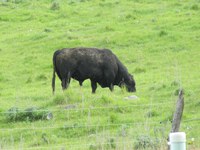Lice in Cattle a Problem
(Click the image below to view a high-resolution image that can be downloaded)
Many North Dakota ranchers are faced with a continual lice infestation in their herd this winter, even though they have treated their cattle.
“Some have even treated more than once and are still seeing the effects of lice in their livestock,” says Ashley Ueckert, a North Dakota State University Extension Service agent in Golden Valley County.
Unfortunately, lice populations are much more difficult to control than they were 10 years ago, according to Gerald Stokka, NDSU Extension veterinarian.
“We cannot be sure of the reason for reduced lice control, but the possibility of resistance to our control products is certainly on the minds of our veterinary practitioners,” he says. “The effectiveness of the pioneer avermectin (macrocyclic lactone) products such as Ivermectin and Dectomax have led them to be used extensively.
“With the development of the ‘pour on’ products, along with the generic products, the use increased, and in some cases, these products were used multiple times per year,” he adds. “So whether we are dealing with resistance in lice or less efficacy at the appropriate dose, the result is the same - a lack of control.”
Here a few options Stokka and Ueckert recommend for helping curb the lice outbreaks:
- Leave the cattle alone. In many cases, the best solution may be to just leave the cattle untreated. Lice populations will begin to decrease in activity rapidly as the weather warms.
- Work with your veterinarian to determine the type of lice you are treating. The likely culprits are the biting lice. Biting lice feed on the dander and scurf on the cattle’s skin and are controlled more effectively with a topical treatment. In contrast, sucking lice feed on blood and serum from the animal and are controlled more effectively with an injectable product that gets into the blood.
- Use injectable and topical treatment to control of both types of lice.
“When looking at topical treatments to treat biting lice, it maybe in your best interest to look for a name-brand product and to use one with a higher-volume dosage,” Stokka suggests. “Biting lice will be controlled more effectively by the parasiticide if they come in contact with it; thus, the higher-dosage products will give you more coverage on the animal and more area for the lice to come in contact with the product.”
NDSU Agriculture Communication - March 8, 2017
| Source: | Gerald Stokka, 701-231-5082, gerald.stokka@ndsu.edu |
|---|---|
| Source: | Ashley Ueckert, 701-872-4332, ashley.ueckert@ndsu.edu |


